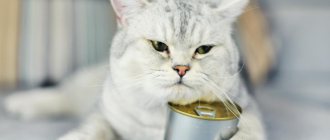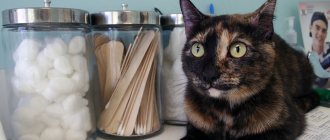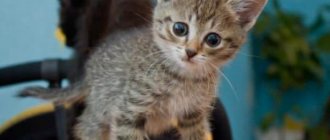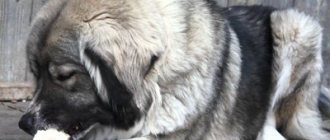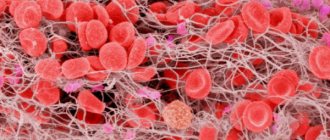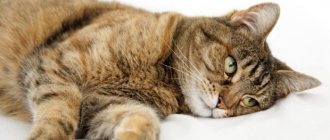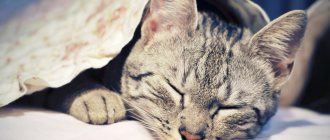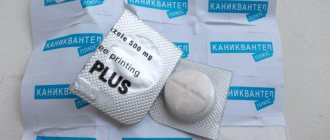Cholecystitis in cats (lat. Cholecystitis) is a chronic or acute inflammatory disease of the gallbladder.
The gallbladder is a pear-shaped organ that stores bile produced by the liver. During the digestion of food, bile is released into the intestines, where it promotes the absorption of fats and stimulates the motility of the small intestine. Bile contains bile acids, bile pigments (bilirubin), phospholipids, and cholesterol. Some bile acids are excreted along with feces, and some are absorbed into the blood and returned back to the liver, where they are reincorporated into bile.
Cholecystitis in cats can occur in acute and chronic forms.
In acute form of cholecystitis
the disease develops suddenly and progresses rapidly.
Causes of acute cholecystitis
can serve:
- obstruction of the bile duct caused by a gallstone, neoplasm of the liver, intestines, pancreas, mucocele,
- infections of a bacterial nature,
- parasites – liver fluke, Giardia,
- injuries accompanied by rupture of the gallbladder.
Symptoms
signs that your cat is having an acute attack of cholecystitis:
- nausea and vomiting of bile;
- refusal of the animal to eat;
- rapid weight loss;
- increased body temperature;
- general weakness;
- pain in the liver area upon palpation;
- yellowing of the mucous membranes and discoloration of feces are possible.
Often the symptoms are nonspecific, which makes diagnosing the disease in the early stages difficult.
Significant deterioration in the animal’s condition, “acute abdomen”, drop in body temperature, frequent shallow breathing, pale gums - may be signs of a ruptured gallbladder. As a result, biliary peritonitis develops - a deadly complication. Such symptoms always indicate the need to urgently take your pet to a veterinary clinic.
Chronic cholecystitis.
It can go unnoticed for a long time and be discovered accidentally during an examination of the animal. If acute cholecystitis is left untreated, it can also become chronic.
Symptoms:
- periodic nausea, especially after eating;
- decreased appetite;
- weight loss;
- indigestion, manifested by alternating diarrhea and constipation;
With chronic cholecystitis, an asymptomatic course of the disease is possible.
The development of cholecystitis is promoted by:
- diseases of the gastrointestinal tract, in which the secretory activity of the stomach decreases;
- poor nutrition (overfeeding, lack of protein);
- gallbladder and liver damage;
The main pathogens are pathogenic microorganisms: streptococci, enterococci, staphylococci, E. coli, which enter the gallbladder from the intestines or distant foci of infection.
What is cholecystitis and why is it dangerous?
What cholecystitis is and why it is dangerous for cats can be learned by learning the general structure and functions of the gallbladder.
The gallbladder is a pear-shaped organ that fits tightly into the quadrate hepatic lobe. It is formed by three layers of fabrics:
- mucous membrane;
- smooth muscles;
- peritoneum.
At the junction of the bladder and the liver, the peritoneum is replaced by loose connective tissue.
The organ is conventionally divided into body, fundus and neck. Concentrated bile accumulates inside it, since more of it is synthesized than is necessary to emulsify fats and ensure the digestion process in the intestines.
The cystic duct emerges from the gallbladder, which, merging with the common hepatic duct, forms the common bile duct, which opens into the duodenum. The sphincter of Oddi is located in this place. If it is open, then the bile flows directly into the intestines, but if it is closed, into the gallbladder.
After performing their function, a certain amount of bile acids is released from the body with feces, and the remaining part penetrates through the walls of blood vessels into the blood and returns to the liver.
With cholecystitis, the metabolic process of bile acids is disrupted, the normal outflow of bile stops, and toxic breakdown products are absorbed into the blood. Clinically, this is manifested by severe pain, disruption of the digestive process, a significant increase in temperature and yellowness of the mucous membranes.
Important! Without proper timely treatment, an attack of acute cholecystitis leads to rupture of the gallbladder, peritonitis and death.
Description
About 30% of all diseases (non-contagious) in cats occur in the liver. This is the most important organ that performs a number of vital functions:
- ensuring metabolism;
- removal of toxins, waste, processed products coming from the digestive tract;
- protein and hormone synthesis;
- energy storage in the form of glycogen;
- blood purification.
If the liver is damaged, these functions cannot be fully performed, which causes disruptions in all body systems. Hepatosis is a liver pathology, manifested in metabolic disorders due to tissue degeneration, as well as degeneration or death of cells (hepatocytes). Dystrophic transformations suppress the normal functioning of the liver, leading to its complete degeneration.
Causes of cholecystitis in cats
Experts identify several reasons for the development of cholecystitis in cats:
- Feeding errors. Most often, cats whose diet consists of economy or premium food suffer from cholecystitis. The imbalance of these diets in terms of proteins, fiber, vitamins and minerals leads to the development of inflammatory processes in the gastrointestinal tract, inhibition of the reproduction of beneficial microflora and increased growth of pathogenic microflora. Pathogenic microorganisms are able to penetrate the gallbladder, provoking the formation of cholecystitis. The situation is aggravated by an insufficient supply of B vitamins, which are necessary for the normal functioning of the liver and bile synthesis.
- Helminthic infestations. The most common helminthiasis in cats whose menu includes fresh freshwater fish is opisthorchiasis. The disease is caused by a trematode that parasitizes the gallbladder and ducts, mechanically acting on their walls, provoking inflammation and creating favorable conditions for the penetration and proliferation of pathogenic bacteria. Accumulating in large quantities, parasites block the outflow of bile and pancreatic secretions. Cholecystitis can also be caused by single-celled parasites such as Giardia. By multiplying vigorously, they line the cavity of the small intestine, preventing the absorption of nutrients and releasing a huge amount of toxic waste products. Gradually, blockage of the bile ducts by parasites occurs, leading to disruption of the outflow of bile and the development of cholecystitis.
- Mechanical blockage of the ducts with stones formed in the gallbladder, as well as malignant and benign tumors.
- Diseases of viral and bacterial etiology , which include infectious hepatitis, salmonellosis, leptospirosis and panleukopenia.
- Mechanical damage to the gallbladder and ducts as a result of an accident, impacts, unsuccessful surgical interventions, compression of the abdominal cavity, etc.
Pathogenic microflora can also penetrate the hepatic ducts through the lymphogenous route.
One of the reasons for the formation of gallstones is irregular feeding. Alternating frequent meals with periods of hunger, as well as feeding once or twice a day, disrupts the rhythm of bile acid production and contributes to bile stagnation.
Why does it develop?
What are the causes of this disease? It just so happened historically that cats were often fed raw river fish. In fact, this approach is fraught with the development of diseases associated with a lack of vitamin B1 and thiamine, but we are not talking about that now. Practice and information from sanitary and epidemiological stations show that river fish in many regions of our country are to one degree or another infected with eggs and larvae of parasitic worms. Accordingly, animals that regularly eat such food almost all have “guests” in their livers. Worms secrete many unpleasant substances, which provoke chronic cholecystitis in cats, which often worsens.
In cities the situation is different. Owners who spend all day at work prefer not to bother and give their pets a whole bowl of dry food, which they eat for years, occasionally getting something more sane (we’ll talk later about what to feed a cat with cholecystitis). As a result, veterinarians have a lot of work to do with urolithiasis, gallstones and inflammation... In addition, dry food (especially those that cost “three rubles a bunch”) provoke the occurrence of severe enteritis. While the microflora is rampant only in the intestine itself, everything is relatively “not bad,” but as soon as it rises through the bile ducts into the gallbladder itself, the animal’s condition becomes even worse. Do not discount infectious diseases of cats, which can also lead to this outcome. The same leptospirosis, hepatitis, plague... All these pathologies often affect the gallbladder.
Predisposing reasons, again, include the same diet. If your pet’s diet is low in vitamin A, you can safely prepare for problems, since the condition of the mucous membrane of the gallbladder depends on this substance. If there is no vitamin, there are erosions that quickly turn into developed cholecystitis.
Acute, chronic cholecystitis
There are acute and chronic cholecystitis, which differ in clinical signs and approach to treatment.
- In the acute form, the attack occurs suddenly, with a rapid increase in symptoms and deterioration of the animal’s condition.
- The chronic form can develop as an independent disease or form after the elimination of an attack of acute cholecystitis. In most cases, it is asymptomatic and discovered accidentally during a routine examination. The danger of this form lies in the possibility of relapses of the disease in the presence of favorable factors.
Symptoms of the disease
Cholecystitis in cats occurs in acute and chronic forms. In the acute form, the symptoms of the disease appear immediately; in the chronic stage, the first manifestations can be noticed after a few days, weeks or even months.
In the chronic course of the disease, the clinical picture is not clearly expressed.
Signs of cholecystitis in cats:
- yellowness of mucous membranes;
- lethargy, apathy, depression, drowsiness;
- decreased, complete lack of appetite;
- indigestion (unstable stool, nausea, vomiting);
- light (white) feces;
- increased thirst;
- dry skin and mucous membranes;
- poor condition of the coat.
In the chronic form of the disease, the cat’s mucous membranes, sclera, and skin turn yellow due to increased release of bilirubin into the blood. Animals look apathetic, lethargic, reluctant to make contact, and refuse to eat. The cat is suffering from debilitating vomiting.
Diarrhea gives way to chronic constipation. The feces are colorless, light yellow. The vomit takes on a yellow-green hue. An increase in temperature and a febrile state is possible if the disease is of viral or bacterial origin.
Symptoms and first signs of the disease
During attacks of acute cholecystitis, it is very important to provide first aid in a timely manner and deliver the animal to the clinic.
The most characteristic signs of the disease are:
- frequent vomiting mixed with bile;
- increase in temperature indicators by 1-1.5°;
- refusal of food;
- lethargy, apathy, avoidance of unnecessary movements, desire for solitude;
- pain when pressing on the area of the right hypochondrium;
- discoloration of stool;
- yellowness of the sclera of the eyes, conjunctiva and visible mucous membranes.
Note! Quite often, jaundice with cholecystitis appears only on days 3-5, and sometimes it can occur after the attack has subsided. Therefore, you should not wait for this symptom to contact a veterinarian.
The following clinic indicates a rupture of the gallbladder:
- a sharp deterioration in the general condition of the pet;
- severe pain and tension in the abdominal wall;
- anemia of the mucous membranes and inner surface of the ears;
- a sharp drop in temperature below normal.
Note! Normal temperature in cats, depending on breed and age, varies from 38 to 39°C.
The result of a rupture of the gallbladder is the leakage of its contents into the abdominal cavity. Bile acids and liver enzymes quickly begin to corrode soft tissues, provoke inflammation and the development of peritonitis. In this case, only emergency surgery can save the cat.
A pet suffering from chronic cholecystitis may have no clinical signs during a period of stable remission. But more often there is a sluggish course of the pathology, manifested by the following symptoms:
- decreased appetite;
- periodic digestive disorders with alternating diarrhea and constipation;
- light color of feces;
- the urge to vomit after eating food;
- gradual loss of body weight with a unchanged diet.
A relapse can be triggered by a cat falling from a great height, abdominal compression, severe stress, or eating fatty, smoked or salty food from the owner’s table.
How to treat?
Let us immediately note that it is almost impossible to cure cholecystitis at home, since you first need to do a lot of tests to determine the factors that caused it. Only then can treatment be prescribed, including the prescription of antimicrobial, antiparasitic drugs, as well as agents that facilitate and stimulate the release of bile from the bladder. This prevents further irritation of the damaged mucous membrane. In short, if you have any of the symptoms that we described above, immediately take your pet to the veterinary clinic.
Proper diet plays a huge role. If your cat suffers from this disease, try to give it soft, low-fat food. Pounded rabbit or chicken puree with vegetables is perfect. In principle, you can use appropriate baby food, since there are no spices or salt. Eliminate dry food immediately and do not feed your cat this crap again! More liquid food, low-fat broths are useful. This is what to feed a cat with cholecystitis.
In this article you can find a lot of useful information that is related to solving one of the common health problems in pets, but you need to understand that this is only informational information, since treatment should only be prescribed by a veterinarian.
Cholecystitis in cats: what is it, symptoms and signs, causes and prognosis
Cholecystitis is a disease of the gallbladder. It can be chronic and acute. This disease is accompanied by: nausea, vomiting, refusal to eat, which leads to weight loss, fever (although with a chronic disease the temperature may not rise for a long time). Often the first sign and alarm bell is discolored stool and general soreness. The reasons can be different: from parasites to injuries, but most often cholecystitis is caused by gastrointestinal diseases.
If the acute form is not treated, it can develop into a chronic form, which may not show itself for years, and at one point the gallbladder will simply explode and the pet will need to be operated on urgently. That is why the disease is serious and needs to be dealt with appropriately and with the help of veterinarians.
Chronic cholecystitis in cats and its description, features of treatment and diagnosis
Chronic cholecystitis may not be felt for a long time and is as serious a disease as its acute form. Often manifested by mild symptoms that need to be taken into account are: - nausea after eating; - constipation; - stomach upset; - weight loss.
Diagnostic methods
It is impossible to accurately determine cholecystitis based on clinical signs alone due to their lack of specificity. Therefore, diagnostic methods have been developed that are carried out in a clinical setting.
These include:
- collection of anamnestic data when the doctor determines the conditions of feeding, keeping and caring for the animal;
- examination, including percussion, auscultation, palpation, assessment of the condition of the mucous membranes and skin;
- general and biochemical blood test;
- Ultrasound of the abdominal organs.
To confirm the bacterial etiology of inflammation, an organ biopsy may be prescribed. This method is also used to determine the malignancy or benignity of an existing tumor. However, a biopsy is an invasive study that requires special equipment and highly qualified specialists. In addition, the preparation of histological material requires several days.
Note! Some reputable clinics now offer scintigraphy, which makes it possible to detect not only cholecystitis or cholelithiasis, but also to recognize malignant formations at the earliest stages of development.
Ultrasound for cholecystitis
During an ultrasound examination for cholecystitis, the following is revealed:
- increased echogenicity of the walls of the gallbladder, indicating their thickening;
- inflammation, focal or diffuse hyperplasia of the mucous membrane of the affected organ;
- heterogeneity of bile;
- expansion of the lumen of the bile duct;
- the presence of stones in the gallbladder.
Blood analysis
As a result of a biochemical blood test in the presence of cholecystitis, an increase in the level of:
- bilirubin more than 7.9 µm/l;
- cholesterol;
- alkaline phosphatase;
- liver transaminases ALT and AST;
- bile acids;
- glutamate dehydrase.
Acute inflammation is indicated by a significant increase in the number of leukocytes in the blood.
Liver failure
Liver failure is one of the most severe liver diseases in cats, occurring in acute and chronic forms. The causes of this disease are severe poisoning or infectious diseases. Symptoms of acute liver failure:
- foul odor from a cat's mouth;
- nervous disorders;
- hemorrhagic syndrome;
- staining of mucous membranes yellow;
- vomit;
- state of shock.
Chronic liver failure occurs much more slowly than acute liver failure, and its symptoms are not as pronounced at first. But over time, the following signs appear:
- refusal of food;
- decreased body temperature;
- liver enlargement;
- vomit;
- blood in feces;
- diarrhea.
Most often, liver failure develops against the background of other untreated diseases, such as diabetes mellitus or hepatosis. Older pets and cats prone to obesity are at risk and are much more likely to be diagnosed with liver failure, which occurs after they have suffered stress.
Treatment regimen for cholecystitis in cats
If a rupture of the gallbladder is detected during an ultrasound or stones are found in it, then surgical intervention is prescribed.
Removal of the inflamed organ, depending on the equipment of the clinic, can be performed by laparoscopy or laparotomy. If the bladder ruptures and peritonitis develops, only laparotomy is used.
In other cases, conservative therapy is prescribed. The treatment regimen for cholecystitis in cats is determined by the treating veterinary specialist and depends on the results of the studies and the presence of concomitant pathologies:
- Diet. This point occupies a key place in the treatment of cholecystitis, since without changing the diet, drug therapy can only give a short-term effect.
- Analgesics and antispasmodics. These drugs help eliminate pain, so they are indicated only in the first days after an attack.
- Means that prevent dehydration and relieve intoxication. With vomiting and diarrhea, intense removal of fluid from the body occurs, leading to thickening of the blood and general intoxication. This can be prevented by intravenous administration of physiological solution with glucose and ascorbic acid, 100 cm3, 2 to 6 times a day. At home, they can be replaced with subcutaneous injections.
- Drugs that support normal heart function. Blood thickening and the release of a huge amount of toxins when the liver malfunctions creates additional stress on the cardiovascular system. Failures in its operation can be prevented by intramuscular injections into the area of the shoulder blade or thigh of caffeine benzoate, cordiamine, carboxylase, sulfocamphocaine.
- If cholecystitis is complicated by bacterial microflora, a course of antibiotic therapy of at least 5-7 days must be prescribed.
- Antihistamines.
- Vitamin and mineral complexes.
- Anthelmintic drugs. If cholecystitis is provoked by parasitic infestations, then effective treatment is impossible without eliminating its root cause.
- Drugs that improve the flow of bile.
The effects of toxic substances on the cat's liver.
Because the liver is involved in drug metabolism, some drugs can cause liver dysfunction in cats. Specific signs and effects are associated with specific medications and their doses. In many cases, the veterinarian must consider the potential danger of the drug to the liver when prescribing treatment.
We invite you to read: Which cat breed is right for you
The cat should be monitored for any signs of decreased or altered liver function. Substances that are toxic to the liver include heavy metals, some herbicides, fungicides, insecticides, rodent poisons, aflatoxins (produced by fungi), some fungi and blue-green algae.
If your cat accidentally receives an overdose of medication, reacts poorly to the prescribed dose, or ingests toxic substances, you should immediately consult a doctor. If necessary, the veterinarian will take actions aimed at reducing the absorption of toxic substances. Depending on the situation, the cat is induced to vomit, activated charcoal is used, the stomach is washed, or an appropriate antidote is prescribed. Any information related to a possible toxin helps the doctor choose the right treatment method.
Because the liver is involved in drug metabolism, some drugs can cause liver dysfunction in cats. Specific signs and effects are associated with specific medications and their doses. In many cases, the veterinarian must consider the drug's potential for liver harm when prescribing treatment and monitor the cat for any signs of decreased or altered liver function.
If your cat accidentally receives an overdose of medication, reacts poorly to the prescribed dose, or ingests toxic substances, you should immediately consult a doctor. If necessary, the veterinarian will take actions aimed at reducing the absorption of toxic substances. Depending on the situation, the cat is induced to vomit, activated charcoal is used, the stomach is washed, or an appropriate antidote is prescribed. Any information related to a possible toxin can help the doctor choose the right treatment.
List of drugs and antibiotics
The above list of medications and antibiotics is given for informational purposes only, and not for self-treatment of cholecystitis in your pet. Their dosage and duration of therapy should only be determined by a veterinarian.
- Antispasmodics: no-spa;
- spazgan;
- papaverine;
- platiphylline.
- cephalosporins (ceftriaxone, cefazolin, cefotaxime, cephalexin, ceftazidime, cephalen);
- tavegil;
- azinox;
- ursodeoxycholic acid;
Feeding ration
If the functioning of the liver and gallbladder is impaired, you should take a very responsible approach to compiling your pet’s feeding diet.
You cannot mix ready-made and natural food, as this leads to metabolic disorders and the development of cholelithiasis.
Natural feeding diet
A natural feeding diet should include fermented milk products with a low fat content, pates made from boiled dietary meat (1-2 times a week - from sea fish), boiled brown rice, buckwheat and oatmeal, boiled carrots and zucchini. Meals should be small and varied.
Therapeutic food for cats with cholecystitis
Pets accustomed to ready-made diets should choose special super premium medicinal cat food for cholecystitis, designed for animals with digestive problems. You can also switch your animal to holistic food, which is ideally balanced in terms of nutrients, vitamins and minerals.
What to feed or how to organize a diet
A therapeutic diet plays a primary role in the treatment of the disease. Veterinarians advise owners of sick animals to feed special industrial feeds for liver diseases.
Ready-made medicinal mixtures are characterized by a low level of fat, high-energy due to proteins, and rich in antioxidants, vitamins and minerals. Medicinal feeds contain a reduced amount of copper and zinc, which has a beneficial effect on the quality of bile. The composition of the feed has a beneficial effect on liver parenchyma and gall bladder function.
If the animal prefers natural food, veterinarians advise owners to reduce the fat content of the products. The basis of the diet should be lean meat - beef, chicken, turkey. Lactic acid products are useful for a sick cat - low-fat cottage cheese, yogurt.
Rice is the best cereal. The diet should include vegetables - carrots, turnips, zucchini. Particular attention is paid to diet. The cat should receive food often, in small portions.
Prevention measures
The main measures to prevent cholecystitis in cats are:
- balanced and nutritious diet;
- the absence of raw freshwater fish and meat on the menu, which are potential sources of helminthic infestations;
- quarterly deworming;
- timely vaccination carried out according to the established schedule;
- minimizing the possibility of injury and stress.
If a cat suffers from chronic cholecystitis, then it must be examined at the clinic once a year to monitor the condition of its organs. This will help to recognize the danger in time and prevent the development of relapse.
Choleretic for cats
Not the least important among diseases of the digestive system in domestic animals is cholecystitis. The pathology affects the gallbladder and manifests itself in chronic or acute form. With the help of bile, the body of a furry pet breaks down fats received from food, and intestinal motor function is activated.
Inflammatory processes in the organ lead to disruption of the cat’s digestive function, cause severe pain and are often accompanied by jaundice and a serious condition of the body.
Read in this article
